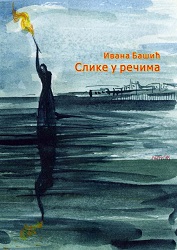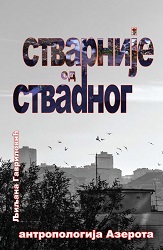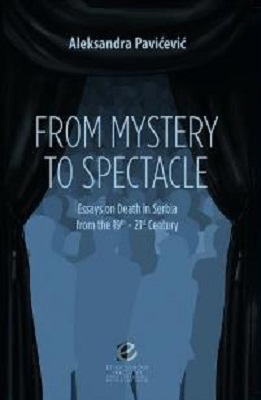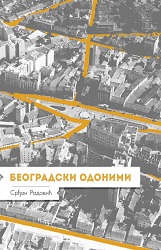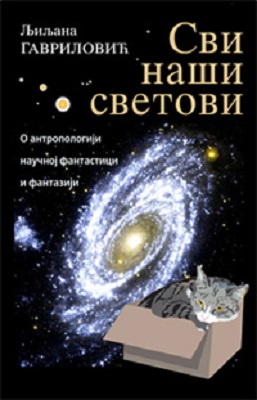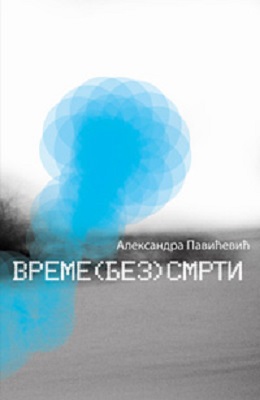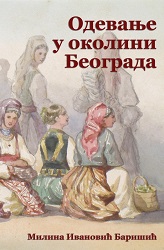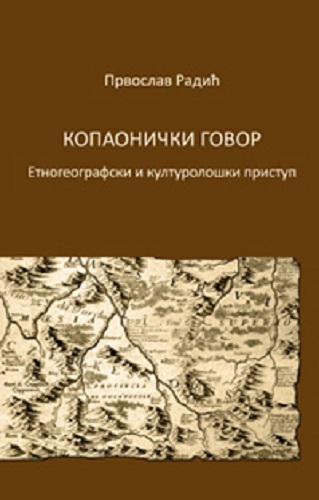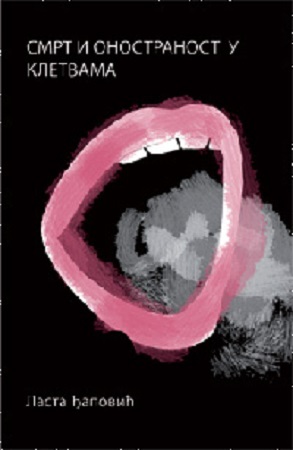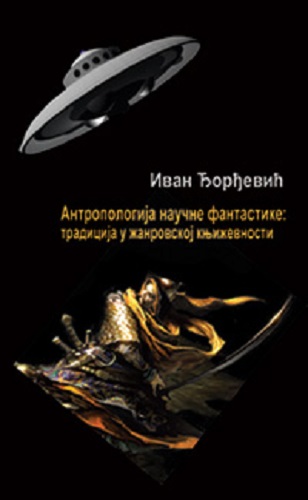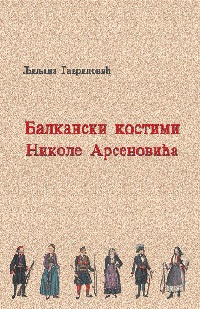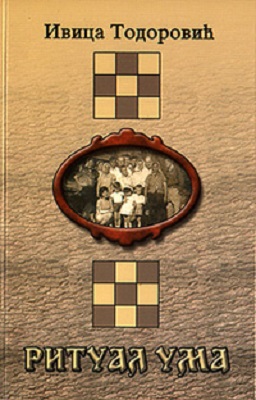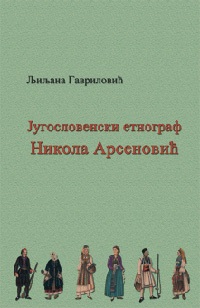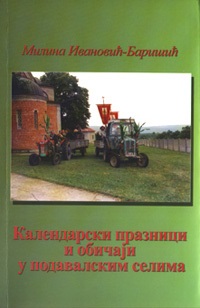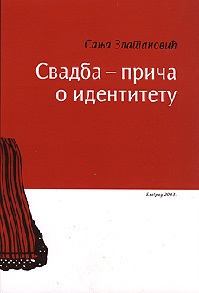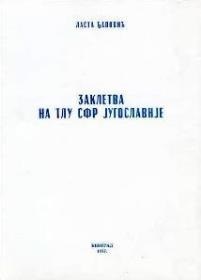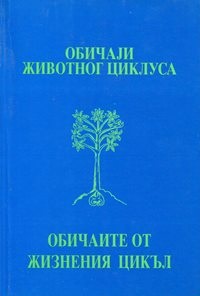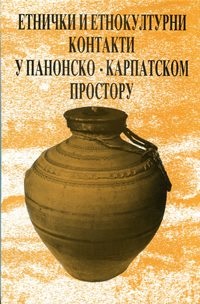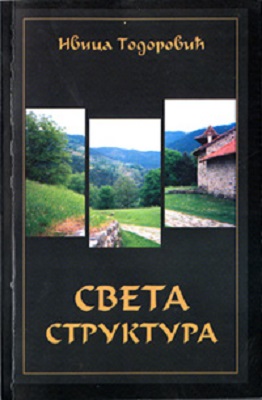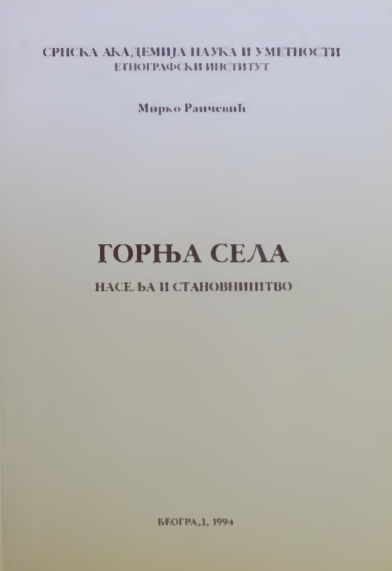Горња Cела - насеља и становништво
Author(s): Mirko Raičević / Language(s): Serbian
Keywords: Montenegro; Gornja Sela; villages; population; Bjelasica; climate; agriculture; history; geography;
Gornja sela is a group of mountainous settlements at Bjelasica's foothill, on west and north-west side from Berane (Ivangrad). This region is situated in the middle between Berane, Bijelo Polje, Mojkovac, KolaSin and Andrijevica. The settlements developed on the southeast slopes of Bjelasica, in the valleys and riverbanks. Jelovica, Suvodola, Gunjara and Bistrica and villages of Vuča and Zagrad are situated on the hillsides of Vuča and Zaučka gora, in the valley and riverside of the Zagradska river. The area was presumably named in the 18th century or maybe some time before, when the newcomers from Brda and Stara Crna Gora settled in these villages and Has as well. Since this group of villages was situated high above Župa, the inhabitants of Župa gave them a single name Gornja sela. Although naturally separated by Vuča's saddle, Zagrad was always considered as one of the villages forming Gornja Sela. It was so since the Šćekić's family settled there as well other clans related to the clans from Gornja Sela. Gornja Sela with Bjelasica behind them, are the widest and the highest part of Berane valley. The highest peak at Galica (Cma Glava) is 2.139 m high, and the lowest settlement (Lubnica) is at 1.000 m above the sea level. In accordance with the real state registry compiled in the fifties, the square area of this region, without Zagrad. is 103.91 km With regard to other estimates the figure is slightly reduced (Mr. Milisav Lutovac, Ph.D. from Ivangrad - Berane valley is of the opinion that Bistrica's river basin encompasses whole region and it is 130.7 km , although the southern part of the river basin belongs to Andrijevica municipality and the western part belongs to Kolasin. Bjelasica, in its long geological history, passed through two glacial ages. During interglacial age river network on Bjelasica was very dense due to thawing of glaciers. During the last Glacial Age the high parts of Bjalasica mountain were covered by glacial. Pointed peaks and mountain ranges stood out from the glaciers (Zekova Glava, Galica. Strmcnički Vrh and etc.). Glaciers were specially high at the mouth of the river Jalovica, Jezerištc, Suvodola and branch sources of the Biogradska river. The highest group of peaks was concentrated on mountain mass Zekova Glava - Galica - Reljina - Šiška - Dolovi with centre at Reljina. On the opposite, east side, there are Bjelogrivac - Ogorelica - Strmcnica (Crna Glava) - Potrkovo with center at Strmcnica (2.122 m). Their glaciers wedged the lake basins, and mud planes at the foot of the highest mountain massif. Bjelasica's massif with its hilltops undergone the change in its releif due to lowering of the bottom (Berane) basin and under the influence of outer forces. Natural resources of Bjelasica and its foothill are considerable. The total square area of this region is 10.391 ha and forests cover almost half of it - 4.756 ha, that is the main source of raw material for lumber industry. Fields and pastures cover the square area of 4.132 ha. Therefore cattle raising was developed in this region. The region is rich in ore that has not been examined yet. Climate on Bjelovica is very severe: Short summers and long winters with sharp transitions with the change of season. The climate at foothill up to 1.200 m is considerably gentler, but at the same time it is more severe than in Berane valley. The difference in microclimate are considerable. That can be seen during vegetation periods at the outskirts of the valleys. Therefore, agriculture and fruit growing areas in Gornja Sela are reduced to river valleys and south sides up to 1.100 m, and occasionally higher. This region, with Bjelasica behind it was one of the richest with water in Berane's district. There are many springs in this region - stronger and weaker, streams, rivers and lakes as well. Waters from Bjelasica are very important for the economy mountain. Richness of water is due to the composition of soil, relief and a lots of rain throughout the year (there is more than 3.000 mm of rain on Bjelasica). Traces of old settlements can be found in this region, they are specially visible above 1.200 m. The traces were destroyed by human work, but they can be found occasionally. Some traces were left by the Illyrians - the ancient inhabitants of this region. Some traces of the Roman culture can be found in Zagrad and Vuča (a village). The ancient fortress, Samograd, bellow Zagrad was certainly build during that period, and the Serbs rebuild it after they settled in this area. The Romans and Roman oriented inhabitants left the traces of huge buildings, usually at the outskirts of present settlements, made of stone and lime. It seems that they were build at the time when our ancestors - the Serbs began to settle, and the Romans moved from the valley to the higher parts of Bjelasica towards the sea. At the time when Budimljanska district was densly inhabited by the Serb population, a part of the population migrated towards the rim, and settled in the river valleys of the Lim tributaries. So, Gomja Sela were inhabited by the Serbs and they became shepherds on Bjelasica. The earliest mention of a village close to Gomja Sela is from 1324/25, the king Dušan, as a young man, gave Zagrad with the other villages as a contribution to St. Peter's church in Bijelo Polje. All villages comprising Gomja Sela were inhabited at that time, and during this period , five or six churches were constructed in Lubnice, Međurečje, Praćevac, Glavac and Zagrad (two). Gornja Sela are region where it is difficult to develop transportation. The region is separated from the valley by mountain massif and the Bistrica canyon and Bjelasica separates it from Potarje. This region was connected with the whole network of main and side caravan roads with the settlements in the valley, Potarje the sides of Bihor. During long winters, when the snowdrifts were much higher than today, the roads were closed for every transport, and they were practically of regional importance. Trading caravans from Potarje passed through this region towards Budimljanska district and Bihor. The tales say that there was a market in Lubnica, Jelovica and Suvodol where cattle and livestrock products were bartered for other goods. After bloody pogroms organized by the Turks in 1653. there was a shift of native Serbs in Gornja Sela. Those who survived clans from Brda and Stara Crna Gora started to inhabit deserted land. But, certain families like Šćekić’s and Obradović's inhabited this region before 1653. During the 18th century and especially after the Turkish programs in 1737/38, the families from different parts of Brda and Crna Gora started to settle in small but closely related groups. They settled depending on their family ties, close to one another if there was enough space. The natives their number decreased due to several Turkish pogroms. Newcomers mostly settled during the first decades of the 19th century. After that families divided the land, and they took certain propertis either in accordance with the master's approval or without in - if the family was a strong one. They also made friends with each other. The inhabitants of this region comprised of nine Montenegrian tribes: the Piper's, the Njeguša's, the Bjelopavlić's, the Bratonožić's, the Kuča's, the Drobnjak's, the Cuca's, the Vasojević's. There were only 16 clans which implies that the clans were young. Although heterogeneous, the inhabitants were united and the territories they occupied were closely related - which were two factors dictated by the historic and life conditions. They were all reduced to survival and the fight against constant enemy. The inhabitants of this region were indulged in cattle raising, above all, and agriculture. Part-time occupations varied from time to time and the composition of inhabitants. The New-comers from different parts of Montenegro brought with them their habits, custom and crafts. Serbs, the natives, knew several crafts that the new-comers did not accept, as for example, blacksmith's trade. They considered it a low job. During the Middle Ages all villages of Budimljanska district belonged to monasteries and churches. There are no information to whom Gornja Sela belonged. We can suppose that they belonged to St. Janja's church in Lubnice. Some villages belonged to their own churches, and their contributions supported the church. After the Budimljanska district was occupied by the Turks (in 1455) the economy of the region basically changed. Crafts and trade gradually ceased to exist, and Turkish masters took the village land. They tyrannized and robbed the Serbs, in the Asiatic way, and they introduced the farming system. After Turkish oppression in 1737/38 ancient Budimljanska district and Has was divided between the Turkish land owners (known as agas) from Plav and Gusinje. Since then Gornja Sela belonged to them and they introduced very cruel ruling system. After centuries of unbearable life under the Turkish occupation, situation in Gornje Polimlje started to change, and strong resistant movement was organized. The situation in Gornja Sela was getting better since this legion was far away from the centers of power and Turkish authorities as well. Therefore, the master’s income was reduced and they became impoverished. After the Great War in 1878. the Turkish land owners started to sell land to the peasants. Until the end of 19th century, all agriculture land in Gornja Sela was bought up, and family clans bought up the land in the mountains and forests. Agriculture didn't develop much since the middle ages. The reason was a simple one - these were mountainous villages where it was difficult to use agricultural machinery. The greatest achievement in agriculture was the use of iron plow instead of the old fashioned single-handed wooden plow, and some facoty produced tools as well. The inhabitants of Gornja Sela took active part in battles and wars against Turkish aggressor since they settled in this region. They were always the first to receive a blow from the Turks from Kolašin and Bihor, and even from Plav and Gusinje. Gornja Sela suffered considerable damage during the liberation war from 1875 to '78 when the villages were burned, and more than 300 hundred people were imprisoned, 40 people were killed, the cattle was taken away and the crops destroyed. Battalion from Gornja Sela was firm support to Miljan. the duke, in all battles with Turks, so even the prince Nikola praized them and refined to them as a "chivalrous battalion from Gornja Sela". People from Gorja Sela fought the Turks until final liberation in 1912. This book didn't deal with participation of people from Gornja Sela in the liberation wars the Balkan War, World War I and II because such a work is under preparation by another chronicler. Gornja Sela, as a spacious region of Berane valley, is of a great importance for the economy of Berane. The society and state has to take care of natural resources - which wasn’t the case up to present - we witness destruction of forests all over Bjelasica. Existing mountain crossings are left untended, or they cease to exist. They used to lead to lakes and spacious pastures. The only passable roads are those used to transport timber. The quantity of timber is measured in millions of cubic meters. Cattle raising has also been neglected. The state can establish acceptable economic conditions and develop them into profitable activities, if based on the local natural resources. Although soil is mostly infertile, agriculture can be advanced, too if a special brand of plants is used. The villages are almost deserted. The young can be kept there only if there is an economic activity going on, and therefore the pressure on cities will be reduced.
More...
